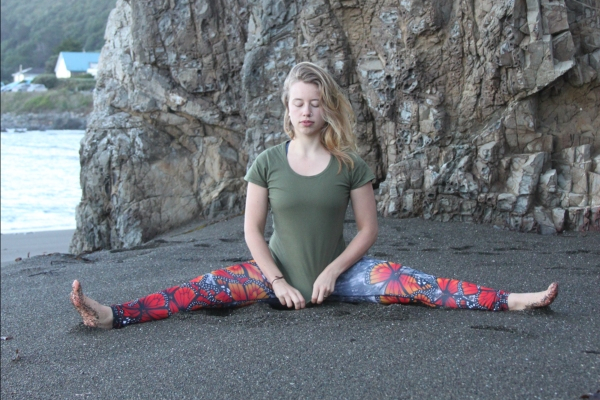
I love yoga, but I’ve become mistrustful of yoga classes. Is it time to challenge my assumptions? Outfit: Courageous Freedom Legskin Tights by Courage My Love
by Lucinda Staniland
I have a confession to make.
Even though I practice yoga every day and work for a yoga website, I haven’t regularly attended yoga classes in years.
My home yoga practice is consistent and serious, I’m constantly consulting my bookcase of yoga books, and I attend the occasional one-on-one session with a teacher. But yoga classes? That thing where you join a group of people to be led through asana and perhaps some pranayama and meditation?
The answer used to be, ‘Yes! Yeah! I love yoga classes and I’m willing to prioritise putting my time, energy and money into them.’ These days it’s more like, ‘Nah, not so much….’
In my late teens and early twenties, I was all about the yoga class, and I would regularly attend three to five yoga classes a week. During that period I soaked up any kind of yoga any time I could get. I was curious and hungry to immerse myself in the world and community of yoga. This was such a gift, as it set me up with a strong foundation for my home yoga practice and indirectly led me to my work with The Yoga Lunchbox.
But for the last five years, I just haven’t wanted to go to yoga classes… ever.
Why? My usual answer is that I have a solid grounding in yoga and no longer need to attend classes for instruction. It’s more cost and time effective for me to practice at home, and it frees up space for doing other things that I love – like sleeping, cooking, being outside and spending time with friends and family.
Plus, practicing on my own at home cultivates my internal teacher, and invites me into a space of deeper intimacy and connection with my body.
Sounds good right?
And it’s true. All of it.
And yet, I’ve been sensing that there’s another reason for my now long-term avoidance of the Yoga studio. Something that’s less to do with time and money and lofty-sounding ideas about the inner teacher, and more related to my perceptions of, and emotional response to, yoga classes, teachers, studios and in fact the whole yoga world.
You see, I love yoga, but I’m not sure I can trust the contemporary yoga scene.
I know, it’s all too easy to become a cynic in the world of modern-day yoga. As yoga has shifted from something that was only at home in alternative counter-cultures to a mainstream business proposition, there’s been plenty for us old-school yogis types to criticise, mock and despair over.
Among other offending items, there’s the aggressive advertising for everything from yoga mats to green smoothies, the rise of yoga hybrids like beer yoga, goat yoga and paddleboard yoga, the thousands of bikini-clad insta-yogis taking over social media, the scandals surrounding Bikram, John Friend and other prominent teachers, and the increase of yoga-related injuries.
This narrative of decline may not be the most useful mindset to bring to the situation, but it’s certainly a visible trend in the yoga community and something we’ve explored repeatedly here at The Yoga Lunchbox.
And based on the available evidence, I do think there’s good reason to be wary of Yogaland as it is today. Yes, it’s easy to be a cynic, but there really is some dodgy, dubious and ambiguous stuff that goes down in the yoga world.
Does that mean that yoga isn’t valuable? No! I value yoga very highly. But it means we all need to apply discernment, and even a certain measurement of scepticism (I like Martin Luther King’s advice to cultivate “a tough mind and a tender heart,”) to navigate Yogaland. But I’m beginning to wonder, have I have swung a little too far in the direction of a tough mind, and neglected my tender heart?
There’s another aspect to this that deepens my caution and mistrust: I love yoga, but I’m not sure I can trust contemporary yoga classes.
My yoga practice has broadened considerably from my early days of studio classes. These days, instead of a set routine of sun salutations and warrior poses, I’m more likely to be practicing a fluid combination of yoga therapy, my favourite physiotherapy exercises, a good dose of self-myofascial release, Yin Yoga, a bit of pilates, some mobility work I learnt from my CrossFit days, a handful of asana, a bit of dance, and some of the time I’m just playing and moving as my body wants to move.
There’s a reason why I practice this way: my practice is totally unique to me and my body, and it can be adapted to match my exact needs at the time. In yoga class, I’ve always struggled with the generic format and large group sizes. How can a teacher keep twenty very different bodies and minds safe in that kind of environment?
When I first started yoga, I had never been injured before, and I felt like my body could handle anything I threw at it. Now, I’ve been injured several times, both on and off the yoga mat, and discovered that body isn’t so bulletproof after all. These days, I find it hard to trust a yoga teacher with my injuries and physical vulnerabilities. Although I’ve always respected and admired my yoga teachers, I’ve come to view their classes with caution. I wonder, will I really be safe here? Do the benefits of being in this class outweigh the risks?
And yet, I know that for all my caution and mistrust, there’s so much that I miss out on when I choose not to attend yoga classes.
There are the invaluable insights and illumination that an outside pair of eyes can bring, there is the inspiration and knowledge that comes from learning from and with others, and then, of course, there are the people.
Yes, the people, for as the Maori whakatauki reminds me,
He aha te mea nui o te ao. What is the most important thing in the world? He tangata, he tangata, he tangata. It is the people, it is the people, it is the people.
Yes, it is the people that we love and connect with that matter. I get that. I feel that. But I’ve been resisting the reality of those people in the yoga community and world.
You see, there’s a very human kind of messiness to yoga classes that I’ve been resisting. It’s the messiness of imperfection—imperfect teachers, imperfect students, imperfect knowledge of the human body and spirit, the imperfect nature of yoga itself and the way we practice and understand it…
But I’m starting to wonder, is that a good reason not to engage with yoga classes?
What if the messy, imperfect nature of yoga classes was actually the whole point?
I recently listened to an interview with Eugene Peterson, a scholar who has translated the Bible into beautiful and poetic contemporary language. I was very struck by his response to the question, “How do I pick a church?”
He said,
“Go to the closest church where you live, and the smallest. And if after six months it’s just not working, go to the next smallest.”
Why the smallest?
“You have to deal with people as they are. And you’ve got to learn how to love them when they’re not loveable.“
That’s it. People aren’t always loveable. Not in the yoga world, not anywhere.
Take yoga teachers, they aren’t always loveable and they’re not always right either. They aren’t always able to keep my body safe in their classes; they might not be able to cater to my unique body and needs; they might have a different perspective to me, or they might understand and practice yoga in a way that I don’t like or agree with. Ditto for other students, who are also liable to be unlovable at least some of the time.
Ditto for the whole yoga world and it’s messy human state. Humans aren’t always lovable, and neither are the things we create. We get things wrong, we don’t agree, we offend each other, we don’t listen closely enough, we prioritise profit over all else, we have incomplete knowledge, we get obsessed with the superficial, we abuse those around us, we get caught up in our own shit…
I’ve become accustomed to keeping a safe distance between myself and the messiness of the yoga world. In some ways, I consider this to be very wise. I know that, for example, that spending time scrolling through many of the popular Yoga themed Instagram accounts is a surefire way to annihilate my sense of self-worth.
I don’t need Instagram yoga in my life, that’s a fact. But the messiness of real-life human community and interaction? Now that’s something that I’ve been missing out when it comes to my yoga practice.
Yes, my home yoga practice is precious to me, and it’s the foundation of what yoga means to me. But I’ve been thinking… maybe group yoga classes are a challenge that I’m ready to revisit, albeit with some caution.
I want a yoga practice that—rather than running away from the imperfect reality of yoga classes and the yoga community—actually embraces people as they are, which also means embracing myself as I am: human, imperfect, sometimes unloveable, and always, always worthy of love.

Amazing Article!
Lucinda, I can totally relate! I worked out for a few days on my own at home and loved it a lot more than I did when I went to classes. It is a lot easier for me to rely on myself and to push my own boundaries than it is to do with my instructor.